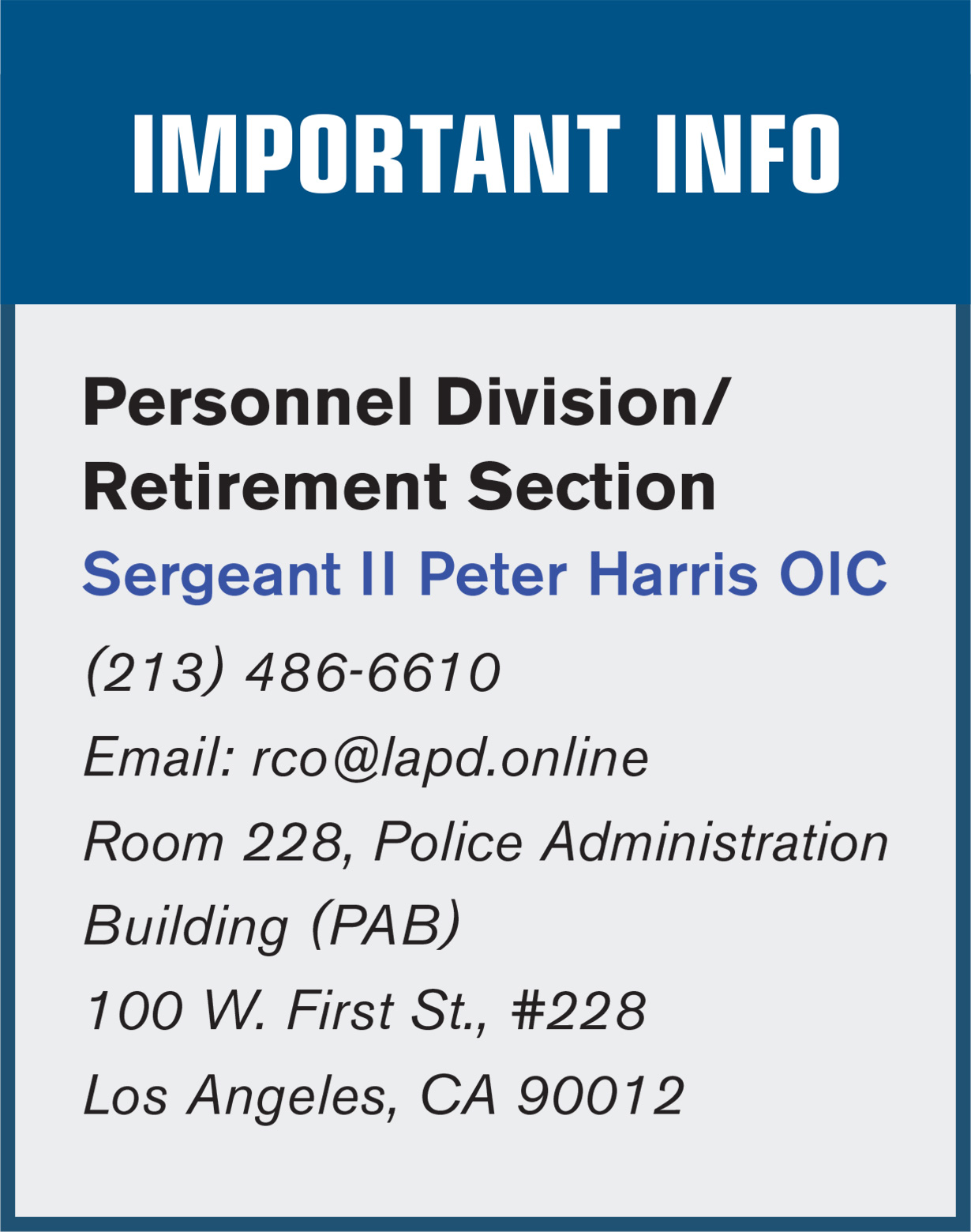 In 2017, I decided to pull the plug on my more than 20 years as an LAPD reserve officer; besides, the commute from Texas was getting a little tiresome over the last three years. After retiring, I received several phone calls from fellow officers asking about the procedure and what they should expect. I coordinated with Lieutenant Curtis McIntyre and Officer Johnny Gil of CODD Section and Sergeant Peter Harris of Personnel Division/Retirement Section to write up the following few simple steps.
In 2017, I decided to pull the plug on my more than 20 years as an LAPD reserve officer; besides, the commute from Texas was getting a little tiresome over the last three years. After retiring, I received several phone calls from fellow officers asking about the procedure and what they should expect. I coordinated with Lieutenant Curtis McIntyre and Officer Johnny Gil of CODD Section and Sergeant Peter Harris of Personnel Division/Retirement Section to write up the following few simple steps.
Simple Steps to “Honorably Retired”
Remember, plan ahead! Don’t walk in and expect to retire the same day as your first appointment with Personnel. There are certain things you are eligible for along the way. The qualification for “honorable retirement” from the LAPD is a minimum of over 20 years of service in any sworn category — Level I, II or III in “good standing.” Each level of reserve police officer differs slightly after that point.
Step 1: Speak to your reserve coordinator, informing them of your intent to retire. They will coordinate a meeting with you and your divisional commanding officer for an exit interview. At this meeting, you will fill out and present your Resignation Form (1.50.00). The completed form will be presented to the C/O and will be signed by both of you. You will take it with you to your meeting with the retirement counselor.
Step 2: Make the two appointments that are necessary with the Personnel Division retirement counselor, on the second floor of PAB (contact info is listed at the end of this article). Prior to the first appointment, they will tell you what you need to bring with you to turn in, as per the Property Clearance Form. Basically, it includes the following: ID card, badge, flat badge (if you have one), cap piece, OC spray, 999 key if you still have one and, depending on your level, duty weapon (unloaded and cleared), body armor, ballistic helmet, OFAK kit (first aid) and baton/PR24. Do not turn in equipment at your division or Piper Tech equipment office before your first appointment with the retirement counselor. The counselor will give you the exact list for each level of reserve to be turned in following your first appointment. You don’t need an appointment with Piper Tech; just go during normal business hours.
Bring your checkbook. For Level I reserves, they will charge you for cleaning your old badge and putting the “Honorably Retired” rocker on the badge. If you want, you can also purchase an identical flat badge with a carry case. For Level I, they will take the serial number from your duty weapon and offer it to you for purchase, with instructions on how to pay for your weapon at the Salvage Desk at Piper Tech. (Note that they only take exact cash for the duty weapon.)
For Levels II and III, you will also need your checkbook. They will offer you your badge encased in Lucite.
Level I will receive a Retired ID card with “CCW Approved.” You will be given a copy of Administrative Order 6 dated June 22, 2011, on how to qualify for LEOSA (H.R. 218). Levels II and III will receive a Retired ID card with “CCW Restricted.”
Step 3: Turn in the required items to Piper Tech; they will check if it was issued to you and sign it off on the form. You can walk next door to the Salvage Department to purchase your weapon (remember, exact change, cash only).
Step 4: Go to your second appointment with the retirement counselor. Present your signed paperwork receipt (Property Clearance Form). Make an extra copy of everything just in case. Their office will walk you through the whole process; they are very cordial and helpful.
At some point, the divisional C/O office will send out advisory letters that mark your years of service and pending retirement. Over time, you should receive several letters of appreciation recognizing your service as a Los Angeles reserve police officer — nice items that your family will appreciate. Usually, they will be delivered to your division of assignment.
You can also get a Letter of Appreciation from the Los Angeles City Council or Mayor’s Office. In some cases, there is a City Proclamation, which is very nice. You can ask your reserve coordinator how to obtain that document. (A personal note: I did get one of these and it was well worth the effort.)
One more thing: Advise the Reserve Unit at CODD that you are retiring. This is a courtesy call and it can save time for their staff in recordkeeping.
That is the entire process. Once you have completed all your steps, you just have to sit back in that big new recliner and enjoy.
Retired Reserve Officer Jim McLaughlin is a director emeritus at the Los Angeles Police Reserve Foundation.
